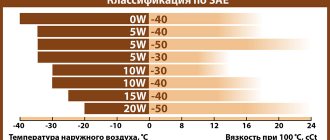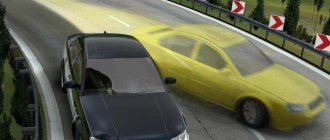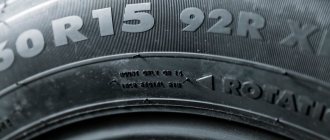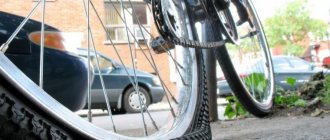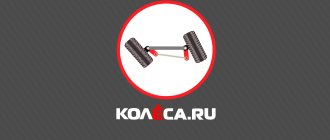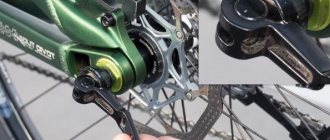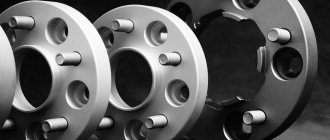A spare wheel and a full-size spare wheel - what's the difference?
Instead of a full-fledged spare wheel of a car, a tire holder takes up less space in the trunk or in the cabin, and helps you get to the nearest service center without outside help if a tire gets punctured on the road. From the name it is clear that it is used in critical situations and “rolled” on it to the repair site.
Why do you need a document?
On a tire, you can drive from 60 to 200 km, depending on the model, without exceeding a speed of 80 km/h. Most brands that equip new cars not with a full-fledged spare tire, but with an additional one, for example, BMW X1, X7, recommend not driving faster than 60 km/h.
The popularity of dokatok is explained by two factors:
- Lower cost.
- Minimum space taken up in the trunk.
It is easier to install a tire on a car due to its light weight, but when replacing wheels, it is necessary to take into account the specific features of the vehicle, first of all, the type of drive.
The first emergency wheel appeared at the same time as a full-size spare wheel, but it has been actively used for the last 10 years. The addition of a re-roller reduces the cost of a new machine - this is the main factor that manufacturers use when equipping single-wheel drive models with it.
The rolling wheel differs from the standard wheel in technical characteristics, weight and size. When choosing a spare wheel, it is recommended first of all to pay attention to the standard sizes - the size of the tire can be no more than 1 inch smaller than the standard tire. If the car is equipped with R15 size tires, then it is necessary to select a tire size with a rim diameter of at least 14 inches.
How does a rolling wheel differ from a standard wheel?
The difference between a re-roller and a full-fledged spare tire is also visible in the materials of manufacture. Standard wheels are made of high-strength steel or aluminum; for emergency wheels, ordinary industrial steel of minimal thickness is used. The emergency wheel tread has a maximum service life of 2,000 km.
Since the contact area of the tire tread is much smaller than that of the standard one, it is necessary to monitor the pressure level in the emergency tire. Experts recommend keeping the pressure in the dock at 4.0-4.2 atmospheres. In some cases, it is possible to increase the pressure to 5 atm.
For example, the characteristics of the tire on the Nissan X-Trail:
- diameter - 17 inches;
- disk – stamped;
- profile width – 155 mm, height – 90%:
- rim width – 40 mm.
For this crossover, you can drive up to 200 km without stopping.
Advantages and disadvantages of a compact spare tire
Like any other product, dokatka has its advantages and disadvantages. The first include:
- Small size and compactness, allowing you not to fill the trunk to capacity.
- Light weight. Changing such a spare tire is much easier than changing a full-size wheel.
- Price tag. The cost of re-rolling is such that even a motorist with the most limited budget can afford it. And this is quite natural, given the amount of materials spent on its production.
- Easy to install/dismantle. Since this wheel is smaller and lighter, it is much easier and faster to install.
- Good prognosis for recovery. Has your dokatka lost weight? It doesn’t matter, because it costs nothing for the master to disassemble and reassemble it.
As for the shortcomings, there are also many of them. And first of all, we are talking about the following serious disadvantages:
- The light weight and dimensions of the dokatka directly affect the safe operation of the vehicle.
- Fragility and low reliability. Due to the fact that tires are made from the cheapest materials, it is not surprising that they fail much faster than conventional wheels. It is worth noting that cutting/piercing such a spare tire is much easier than a full-size one.
In principle, the dokatka has more advantages than disadvantages, but this does not mean that you need to choose just such an alternative. And if you have extra money, then it always makes sense to purchase a full-size wheel as a spare, and not a smaller copy of it in a budget version.
Features of control and movement on the emergency wheel
Even if the original dokatka is installed, the nature of driving the car changes, the electronic control unit, differentials, etc. begin to work differently. What the driver needs to remember:
- The braking distance increases by 120% due to the reduced contact area of the tire tread with the road.
- If the difference in angular speeds increases on the axis where the emergency wheel is installed, there is a danger of damaging the differential.
- Stabilization systems (ESC) must be turned off if the size of the tire wheel is critically small and differs from the standard wheel size by more than 1 inch. The system may malfunction and incorrectly redistribute torque to the wheels due to the fact that a smaller disc diameter may be recorded as slipping.
Nowadays
Modern cars are equipped with full spare wheels, emergency wheels or wheels with run-flat technology.
- The spare wheel can be the same type and size as the standard one
. It can be mounted in a steel rim or on the corresponding running wheel of the machine. Among passenger cars, SUVs and light trucks are usually equipped with full spare tires, since rolling them back will have an adverse effect on vehicles with a high center of gravity. Due to the size of a full-fledged spare tire, it is often mounted on the outside: on the rear door of SUVs, sometimes on the hood. Such a wheel is included in the tire rotation: from time to time one of the wheels becomes a spare, while the spare is mounted on the axle. - Some cars are equipped with emergency wheels, called “dokatka”
. Designed to reduce cost, vehicle weight and/or save space compared to a full spare. A dokatka is a tire of reduced size (both in diameter and width) mounted on an inexpensive steel wheel. Due to the short service life and low permissible speed, the re-roller can only be used over short distances. Due to the different sizes of the tire and the standard wheel, the electronic stability control and traction control system will not work correctly - they must be turned off before driving off. - In some cases, cars are equipped with run-flat tires
, which eliminate the need for a spare wheel. Other cars carry cans of repair foam to seal punctured tires. However, this often does not work in the event of a large puncture and is completely useless in the case of a tire blowout.
How to install a dokatka on a car depending on the type of drive
Manufacturers recommend not installing a spare wheel on the drive axle. If the front tire in a front-wheel drive car is punctured, it is recommended to carry out a full replacement: remove the rear wheel, move it to the front axle, and install a tire at the rear.
What is special about riding a dokatka?
Many drivers neglect this procedure, since it is quite difficult to remove two wheels from the car on the road.
If the car has a drive on the rear axle, it is necessary to install the wheel on the front axle. This will minimize the load on the differential, but will significantly reduce handling. The speed with this installation should not exceed 50-60 km/h.
Rules for using the emergency wheel:
- When entering a turn, it is advisable to slow down as much as possible.
- When driving, you should avoid sudden maneuvers; you should not suddenly slow down or pick up speed, as the car may skid.
- Experienced drivers advise not to disable electronic systems that will help newbies hold their car in a critical situation, despite their possible incorrect operation.
No matter how strange it may seem, driving a car with a rebuilt vehicle requires the driver to have the appropriate experience.
Fine for driving on the dock
Officially, the traffic rules do not provide for a fine for a re-rolling wheel, however, there is a clause according to which wheels installed on the same axle of a car should not have different sizes, designs, tread patterns, etc.
On the other hand, if a tire gets punctured, the driver can put on a spare tire (including a spare tire) and move to the parking lot or repair site, taking precautions. It turns out that the inspector will not issue a fine for driving a tire if the tire gets punctured while driving and the driver is driving in the direction of a tire repair shop.
You cannot operate (go about your business) a car on a dock - this will be a violation of traffic rules and may entail a fine, the amount of which, according to Article 12.5, Part 1 of the Code of Administrative Offenses of the Russian Federation, is 500 rubles.
A tire wheel is an invention that allows you not to carry a full-size wheel with you, saving money on its purchase, as well as space in the car. But such a wheel negatively affects handling and, accordingly, jeopardizes the safety of the driver and his passengers.
Therefore, you need to operate the re-roller carefully, observing safety precautions and not exceeding a speed of 70 km/h
If the material was interesting or useful for you, publish it on your social network page:
Is it possible to ride on a tire?
The traffic rules in this matter are clear: the tire tire is used only in an emergency, and you can only ride it to the place of repair - to a tire repair shop or to a garage.
It is not designed for speed and has distance restrictions. The fine for constant use of the dokatka is 500 rubles.
An emergency tire will allow you to quickly get out of a difficult situation and get to a repair shop, but only if the tire was punctured not during a long trip. You cannot use the tire all the time; before the trip, you need to properly inflate it and monitor the pressure level. And yet, a full-size spare tire remains the best option for replacement - it allows you to not lose either speed or control.
What is a dokatka?
A special spare wheel is called a dokatka. It has smaller dimensions (thickness and diameter), can be without an air-filled tire, the design is lightweight, and the tread is shallow. It is installed instead of the main wheel damaged along the way. The only purpose is to slowly drive (“roll”) to the tire repair station. Some models have the same diameter as standard wheels.
Since the tire is smaller than a standard wheel, high pressure is maintained inside it (in winter - 4.2 kg / sq. cm). It is recommended to check it regularly, because It’s not at all a fact that there will be something to pump up the tire on the way. If it is equal in diameter to the standard, then the design is necessarily lightweight. It is easy to install and saves fuel when driving. By the way, you need to drive carefully, because driving with a mini-spare spare is more difficult than in a normal case. The maximum speed is 100 km/h (although it is generally recommended to go no faster than 60 km/h).
Each car model has its own “own” documentation. Due to difficulties with control, such a spare tire is not recommended for beginners. But it will be very useful for experienced drivers.
Return - exchange
If necessary, you can make an exchange or return within two weeks from the moment you receive the delivery document from the transport company. Shinportal does not compensate for carrier services, tire fitting, etc.
Source: shinportal.com
The newcomer to the Russian market, Renault Kaptur, will definitely miss a certain number of buyers due to its configuration features, which the manufacturer apparently considered not very important in the competition. We are talking about some illogicality in equipping this model with a spare wheel. This is in no way an attack on the rather bright and engineering-harmonious Kaptur, but just an example. But many of Captyura’s competitors have complete order with a spare wheel. For example, in the Hyundai Creta, a full-size spare wheel, at least on a steel disk, is placed in the trunk - for all trim levels. This is the normal approach of a manufacturer intending to achieve good sales (and at the same time reputation) in Russia.
If we assume that the single-wheel drive version of the Captur will be chosen mainly by city dwellers for the “house-dacha” mode, then perhaps the extras would be enough for them. But with Captur it’s the other way around. What were Renault thinking when they decided that a full-size spare tire would only be available for the single-wheel drive version, and that the all-wheel drive would be equipped with an inferior spare tire?
We thought about good things
And my colleague and I, not far from the Arctic Circle, once had the opportunity to contemplate a Nissan Juke, trudged with a flimsy stowage on the front axle along an endless Karelian grader. We hope his crew arrived safely at some workshop.
On the other hand, a tire puncture is by no means an everyday or regular occurrence. Many people have been driving for years, on these same roads and around them, and everything is fine! Should you worry if there is a small bagel in the trunk? Maybe a dokatka will do?
Off-road repair kit
A repair kit instead of a spare tire is becoming a very common option and is slowly moving from the premium segment to simpler cars. Although tinkering with wheel repair in our specific country, where sometimes there is no roadside, is a task for a keen connoisseur. However, it is in any case easier to imagine the owner of a Kia Rio with a “plug” and glue in his hands than a driver of a Porsche or Cadillac.
If the “Run Flat” technology (literally, “run flat”) reaches budget cars, it won’t be for a long time. Tires with reinforced sidewalls and a bead ring that prevents a flat tire from sliding off the rim are a good thing in themselves. They are less susceptible to damage in principle, and with a puncture they can easily withstand a hundred kilometers. That's what they were invented for.
Run-flat tires are ideal for drivers who do not plan to get out of the car at all due to a flat tire. But they have a number of disadvantages that make it difficult to transfer them to mass production machines. They are significantly more expensive, heavier and stiffer, require advanced suspensions and pressure sensors designed for runflat, wear out a little faster, and are even repairable only in particularly favorable cases. We don't need this kind of runflat! We are not ready for it, although factories assure that 12% of the world's drivers have already chosen safe run-flat tires.
We must be aware that for the inhabitants of the premium segment, the listed disadvantages are not disadvantages. God help them! But for us too, since repair kits and spare parts, for objective reasons, do not inspire the necessary peace of mind and confidence over long distances.
Half of Russians, according to one survey, consider Russian roads to be bad or very bad - and this is exactly what they are in half the cases. The sheer number of tire fitting stations in Russia makes it clear that there is something wrong with our roads, and the tire fitting business is in demand not only during the seasons of changing sets.
Dokatka - good or evil?
Everything else is ambiguous and requires study. It is possible that a re-roller is more expensive to produce than a regular wheel, and therefore its presence makes the car more expensive. It is possible that when using a re-roller, overheating of the differential and hub may occur, as well as the vagaries of the ESP system (if there is a large difference in diameter with the standard wheels).
And absolutely, with the factory-recommended speed limit of 80 km/h, the dokatka spoils handling and increases the braking distance. If you are standing in front, then when accelerating the car is noticeably pulled towards the wider tire (when braking - vice versa). And when installed at the rear, ZR testers several years ago did not dare to do the “rearrangement” exercise on wet asphalt - the impressions from dry asphalt were enough.
Naturally, no one demands any feats from the dokatka, it’s just a crutch, its task is to help you hobble to the workshop. Therefore, avoid heroism and, if you have to, try to put the tire on the rear axle - it’s safer. And carefully read the instructions regarding the pressure in the dokatok - the usual values are not suitable for it.
A separate topic is the relationship between the dokatka and the law. Clause 5.5 of the “List of faults and conditions under which the operation of vehicles is prohibited” directly prohibits the installation of tires of different sizes and designs, with different tread patterns, etc. on one axle. At the same time, the traffic rules contain clause 2.3.1: “If other malfunctions occur along the way (...), the driver (...) can proceed to the place of parking or repair, taking the necessary precautions.” A broken wheel or a broken tire is not one of the faults in which driving is strictly prohibited.
Isn’t it time to introduce a clause into the laws for additional evidence, which has long ceased to be an isolated phenomenon? For example: “Operation of a temporary spare wheel (emergency wheel) provided by the vehicle manufacturer is permitted only in cases and modes specified by the manufacturer.”
We need to get used to it!
Source: www.zr.ru
More and more modern cars, instead of a full-fledged spare wheel, are equipped with a so-called spare tire.
The tire tire has a smaller diameter and thickness and serves only one purpose - in the event of a puncture of the standard tire, to allow the car to get to the nearest tire shop under its own power.
The popularity of dokatok is explained, as a rule, by layout reasons: it takes up much less space in the trunk, plus, if you wish, you can carry several dokatki with you. This is especially necessary for those who are going on a long country trip, because if several wheels are damaged at once, they can all be replaced and slowly crawl to the repair site.
It is important to remember that a rolling wheel is not a full-fledged wheel.
Due to the small diameter and lack of an air-filled tire, the load on the vehicle's suspension and differential increases significantly.
Accordingly, many problems :
- Firstly, the contact area with the road is greatly reduced. As a result, there is a significant increase in braking distance and deterioration in controllability.
- Secondly, as mentioned above, the differential suffers. The reason is the increased difference in angular speeds between the wheels on the axis where the roller is installed.
- Thirdly, the electronic stabilization systems - ABS, ESP, DSTC - stop working adequately. When using a re-roller, they perceive the smaller diameter of the disc as slipping and begin to fight it, which gives the driver a lot of unpleasant minutes.
- And fourthly, which is obvious, the re-roller is more “fragile” compared to a standard wheel and is easily damaged by potholes and potholes.
The greater the difference between the diameters of the tire and the other three wheels, the more the above problems will be aggravated. If such a difference is small and does not exceed 1 inch, then you can move quite tolerably - the stabilization systems will work correctly, and therefore will help in controlling the car and when braking.
The load on the differential will also not be excessive and there is no need to worry about its serviceability.
However, you should not be mistaken in thinking that you can drive with such a spare wheel as if you were using a full-fledged spare tire.
The tire tread depth is designed for 2000-6000 kilometers; it quickly wears out, further increasing the braking distance.
In addition, a car equipped with wheels of different sizes may behave unpredictably when cornering, especially in snow or rain.
If the diameters differ by 3 inches or more, be sure to turn off the electronic systems before driving.
After all, if this is not done, the wheels will constantly be blocked, since the electronics will “think” that the wheels on the same axle have different coefficients of adhesion to the road, and will slow down one of them.
Do not forget also that with such a difference in diameters, a huge load falls on the differential.
Driving over a distance of 100 kilometers at a speed of more than 60 km/h may be fatal for your car.
To minimize the negative effects, place the dokatka on the vehicle axle that is not the drive axle. But at the same time, you need to take into account that if you have a rear-wheel drive car, then attaching the tire to the front axle will allow you not to worry about the differential, but it will significantly worsen the car’s steering, especially in winter. In slippery road conditions, you will have to slow down as much as possible before making sharp turns and you will need to operate the steering wheel more smoothly. If there is a sharp change in course, the weak tire tread will not be able to immediately cling to the road surface and the car will roll straight, despite the fact that its steering wheels are turned to the side. On the other hand, a dokatka placed on the rear axle will grind on a slippery surface, which, in addition to making the start difficult, also destabilizes the car’s behavior in corners, causing constant skidding. We can recommend the following - if maintaining braking distance in icy conditions is important to you and you drive on good winter tires, then it is better to put the tires forward. One of the steering wheels is still “dressed” in winter tires, which have excellent grip on icy asphalt. With competent, well-thought-out actions, you can easily get to the repair site. Many drivers still advise not to turn off the stabilizing systems, despite their clearly inadequate operation, they just need to move at a minimum speed, avoiding sharp accelerations and changing lanes without special need.
On front-wheel drive cars, we definitely put the wheel back, saving the differential and maintaining controllability at the proper level.
In conclusion, we note that a dokatka is a very convenient and necessary thing. Thanks to its compact size, it fits easily into the trunk without taking up much space. If you wish, you can have more than one document with you, further protecting yourself from surprises during the trip. Its disadvantages are also eyewitnesses and are given above.
If you are an inexperienced driver who still doesn’t “feel” the car well, it’s better not to tempt fate and carry with you a full-fledged spare wheel with a high-quality tire.
Well, everyone else can be advised to be more careful when using such an “alternative” spare wheel, and try to equip your car with a spare wheel that is close in diameter to the standard wheels.
Source: www.drivingplus.ru
Dokatka photo
